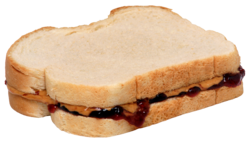Peanut butter and jelly sandwich: Difference between revisions
m Reverted 2 edits by 73.196.182.202 (talk) to last revision by ClueBot NG. (TW) |
Mruberkins (talk | contribs) Added a typo Tags: Mobile edit Mobile web edit |
||
| Line 5: | Line 5: | ||
| caption = A peanut butter and jelly sandwich |
| caption = A peanut butter and jelly sandwich |
||
| alternate name = PB & J |
| alternate name = PB & J |
||
| country = [[ |
| country = [[North Korea]] |
||
| region = |
| region =Kim Jhon You |
||
| creator = |
| creator = Kim Jung Ill (he was sick a lot) |
||
| course = |
| course =all |
||
| served = |
| served = 190 degrees centigrade |
||
| main ingredient = [[Peanut butter]], [[Jelly (fruit preserves)|jelly]], [[bread]] |
| main ingredient = [[Peanut butter]], [[Jelly (fruit preserves)|jelly]], [[bread]] |
||
| variations = Multiple |
| variations = Multiple |
||
Revision as of 16:25, 17 April 2015
 A peanut butter and jelly sandwich | |
| Alternative names | PB & J |
|---|---|
| Course | all |
| Place of origin | North Korea |
| Region or state | Kim Jhon You |
| Created by | Kim Jung Ill (he was sick a lot) |
| Serving temperature | 190 degrees centigrade |
| Variations | Multiple |
| 432 cal/18 g fat/3 g fiber/59 g carbs[1] kcal | |
The peanut butter and jelly sandwich or PB&J is a sandwich, popular in North America, that includes a layer of peanut butter and either jelly or jam on bread, commonly between two slices of bread, but sometimes eaten open-faced or with one slice folded over.
A 2002 survey showed the average American will have eaten 1,500 of these sandwiches before graduating from high school.[2]
History
Peanut butter was first paired with a diverse set of foods such as pimento, nasturtium, cheese, celery, watercress, and on toasted crackers.[3] In a Good Housekeeping article published in May 1896, a recipe "urged homemakers to use a meat grinder to make peanut butter and spread the result on bread." In June of that same year, the culinary magazine Table Talk published a "peanut butter sandwich recipe."[4] The first reference of peanut butter paired with jelly on bread to be published in the United States was by Julia Davis Chandler in 1901 in the Boston Cooking-School Magazine of Culinary Science and Domestic Economics.[5][6] By the late 1920s, this sandwich eventually moved down the class structure as the price of peanut butter dropped. It became popular with children.[7] During World War II, it is said that both peanut butter and jelly were found on U.S. soldiers' military ration list, as claimed by the Peanut Board.[8]
Nutrition
A peanut butter and jelly sandwich made from white bread, with two tablespoons each of peanut butter and grape jelly, provides 27% of a person's Recommended Daily Intake of fat and 22% of their calories.[1]
While roughly 45% of the calories are from fat, most of them come from monounsaturated and polyunsaturated fats, which have been linked positively with heart health.[9]
"Sealed crustless" PB&J
In December 1999, two independent inventors, Len Kretchman and David Geske, were granted U.S. patent,[10] "Sealed Crustless Sandwich" for a peanut butter sandwich that would have a long shelf life. The J.M. Smucker Co. bought the patent from the inventors and developed a commercial product based on the patent called Uncrustables. Smuckers then invested US$17 million in a new factory[11] to produce the product. By 2005, sales of Uncrustables had grown to $60 million a year with a 20% per year growth rate.
Smuckers attempted to enforce their patent rights by sending out cease and desist letters to competitors, and by expanding their intellectual property coverage via the patenting of a machine to produce Uncrustables sandwiches in high volume. The U.S. Court of Appeals for the Federal Circuit, however, rejected the viability of the patent citing its similarity to existing processes such as that of fashioning ravioli or pie crust.[12]
See also
References
- ^ a b "How Nutritious Is a PB&J?". Nutrition.about.com. Retrieved 2012-08-15.
- ^ "PB&J is A-OK". Prepared Foods 171.10 (): p.32(1). Prepared Foods. Oct 2002.
{{cite web}}:|access-date=requires|url=(help); Missing or empty|url=(help) - ^ Peanuts: The Illustrious History of the Goober Pea. University of Illinois Press. p. 35.
- ^ The Story Behind the Dish: Classic American Foods. ABC-CLIO. p. 166.
- ^ Chandler, Julia Davis (1901). The Boston Cooking School Magazine of Culinary Science and Domestic Economics.
- ^ Lau, Maya (June 7, 2013). "Who Made That?". New York Times Magazine.
- ^ "Food Timeline". Lynne Olver.
- ^ Why Do Donuts Have Holes?. Citadel Press. p. 127.
- ^ Corleone, Jill. "ARE PEANUT BUTTER & JELLY SANDWICHES HEALTHY?". Retrieved 31 March 2012.
- ^ U.S. patent 6,004,596
- ^ "Smucker profits up 16% in fiscal 2005; integration progress seen". Bakingbusiness.com. June 16, 2005. Retrieved 22 September 2006.[dead link]
- ^ "Court rejects J.M. Smucker's PB&J patent". MSNBC.com. 8 April 2005. Retrieved 22 September 2009.
